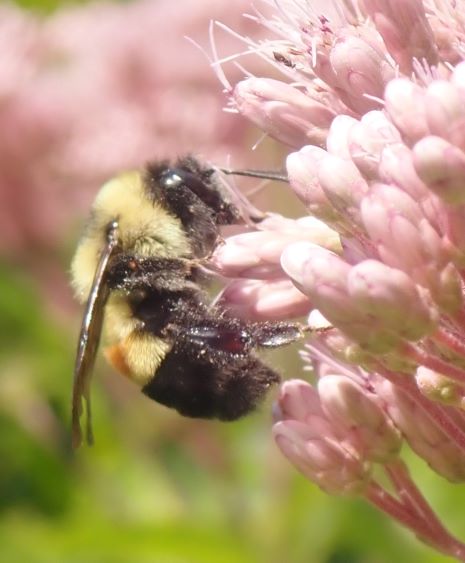Photo by Angus Mossman Federally-endangered rusty patched bumble bee on joe-pye weed in shrub swamp.
By Mike Mossman, Amy Staffen and Angus Mossman
The recent addition of the Dischler tract to WSO’s Harold and Carla Kruse Honey Creek Nature Preserve has inspired renewed interest in current and longterm management needs at this very rich and important natural area. The 372-acre preserve includes a wide diversity of plant-animal communities: wetlands like streams and springs, sedge meadow, and swamps of alder, hardwoods, pine and tamarack; upland communities that include oak and maple forests, pine and hemlock relicts, cliffs and prairie remnants; and anthropogenic communities like pasture, cropland and old field.
This intricate mosaic of habitats, set within its landscape of the Baraboo Hills and the Honey Creek valley, provides for the preserve’s wonderful variety of birdlife—as well as for many plants and other animals that are rare or in need of conservation effort.
Yet, we shouldn’t take this rich diversity for granted, for it is influenced by many forces of change, which we as land stewards are responsible to manage or respond to wisely. Some of these influences are historic, some current, and others loom on the horizon: invasive exotic plants, climate change, grazing, logging, ditching, disease, succession, lack of fire, high deer populations, beaver activity, direct human use, upstream land uses, etc.
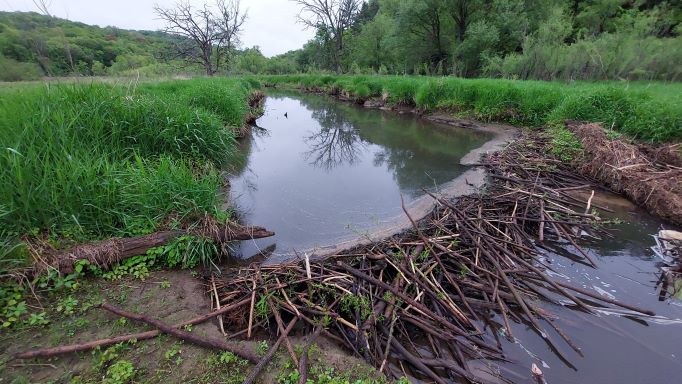
Photo by Mike Mossman Beaver dam on Honey Creek, with flooded bur oaks in distance.
WSO’s Honey Creek Committee recently directed us to assess the ecological condition of the preserve, identify management issues and draft a new management plan. Our first step was a careful review of flora and fauna and their relationships with topography, soils, habitat type, and historical factors. We will now review these data along with previous management plans to identify a suite of options for the committee to consider, including trajectories for future desired conditions, management goals and objectives.
This past spring, summer and fall the three of us conducted field surveys, mapping natural community types, noting dominant plant species, structural characteristics, condition, history, management issues and restoration potential. Amy served as lead and also produced GIS maps and community classifications according to DNR Natural Heritage Inventory criteria. Mike conducted Breeding Bird Surveys, mapping birds according to management units. Angus ramped-up his longer-term surveys of invertebrates (including periodic night-lighting in different communities), and of vascular and nonvascular plants, especially lichens. We consulted previous plans, surveys and databases of fish, birds, plants and ecological communities to mine them for historic data and insights.
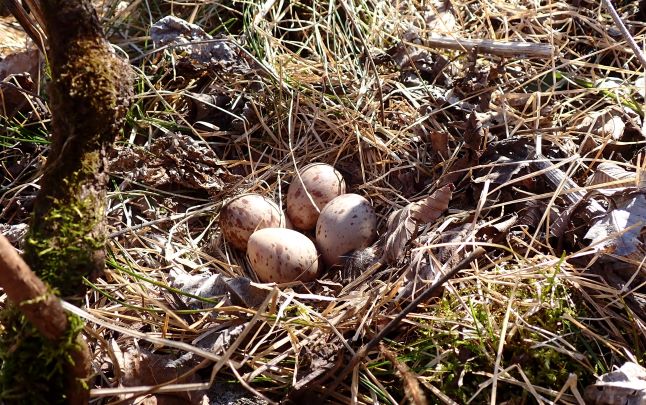
Photo by Angus Mossman American Woodcock nest in a young black ash swamp at Honey Creek.
What did we find?
We recognized some 23 natural communities, and mapped about 70 fine-scale management units, each representing a particular community, history, site characteristic, condition and restoration potential. We recorded 75 bird species during breeding season and obtained positive evidence of breeding for many.
Upland hardwood and mixed forests range from moderately disturbed to old-growth quality, and some have potential for restoration to fire-maintained oak woodlands and savannas. Upland forest birds are typical for Baraboo Hills, including many Eastern Wood-Pewee, American Redstart, Rose-breasted Grosbeak, Red-eyed Vireo and Ovenbird, all 7 local woodpecker species, and 15 pairs of Acadian Flycatcher, which nest mostly on slopes in mature mixed hardwood-conifer forest.
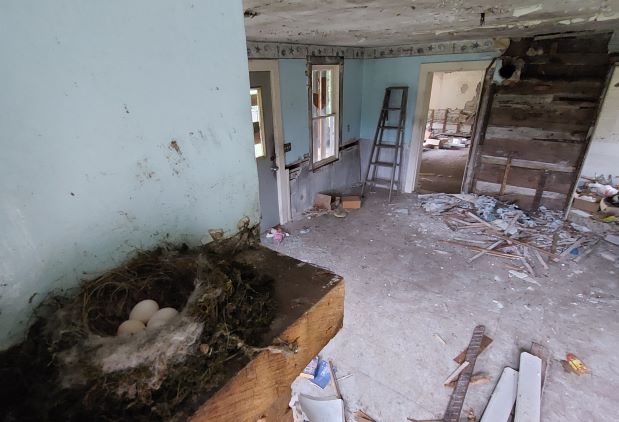
Photo by Mike Mossman Eastern Phoebe nest in the kitchen of the old Cox farmhouse at Honey Creek. The log cabin remains inside the farmhousehave since been salvaged and removed from the site. The remaining debris has been piled into the basement while WSOexplores options for its disposal and restoration of the site.
This year Mike found only one Cerulean Warbler, as well as a Northern Parula, both singing from some of the largest trees on the site.
Pine and hemlock relicts and their associated cliffs contribute much to the preserve’s scenery, and to its diversity of insects and plants, though they support none of the northern bird species that characterize larger and less isolated relicts in some other Baraboo Hills sites.
Goat prairies associated with these cliffs also contribute plant and insect diversity, but in the absence of fire or other management they have shrunk considerably since the preserve was established, as the surrounding forests have encroached. These remnants could be expanded and restored, but currently have almost no apparent effect on the breeding birds. Three isolated areas of abandoned fields now support only a few common edge birds like Song Sparrow and Common Yellowthroat, but they present additional opportunities for restoration to oak savanna or woodland, which could benefit species such as Red-headed Woodpecker, Blue-winged Warbler and eventually Cerulean Warbler.
Wetland complexes here are in a fine-scale mosaic, favoring birds that readily range among different types. The widespread and habitat-generalist Common Yellowthroat and Red-winged Blackbird are common, as are other species in greater need of conservation, such as Black-billed Cuckoo, Willow Flycatcher and Swamp Sparrow.
Most remarkable is the high number—at least 40 pairs—of Veery, which nest here in many habitats, especially alder and pine-ash swamp, and at the lowland-upland transition. These wooded wetlands are threatened by the alternating drought and extreme flooding of recent decades, invasion by reed canary grass, and the recent epidemic of Emerald Ash Borer. The threat of invasives is greatest where black ash and tamarack are dying.
Louisiana Waterthrush remains a characteristic breeder along the clean streams on the WSO tract, and Mike found 4 to 6 breeding pairs, which are fond of spring seeps at the base of forest slopes.
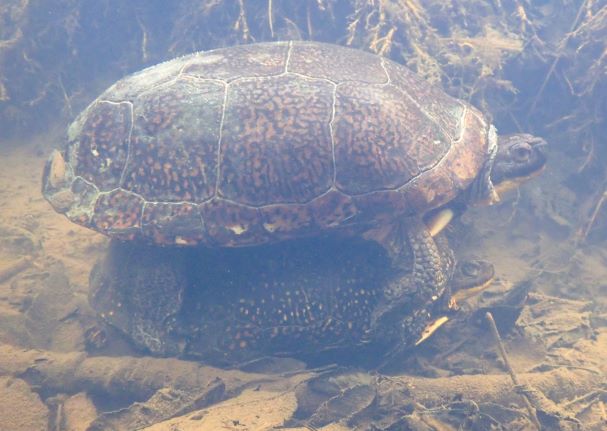
Photo by Angus Mossman Blanding's turtles mating underwater in pine-ash swamp.
Throughout 2021 and 2022 Angus inventoried additional flora and fauna. Noteworthy finds included several observations of the federally endangered rusty patched bumble bee (Bombus affinis), a new state record of a leafhopper (Norvellina novica), and a mating pair of the state special concern Blanding’s turtle.
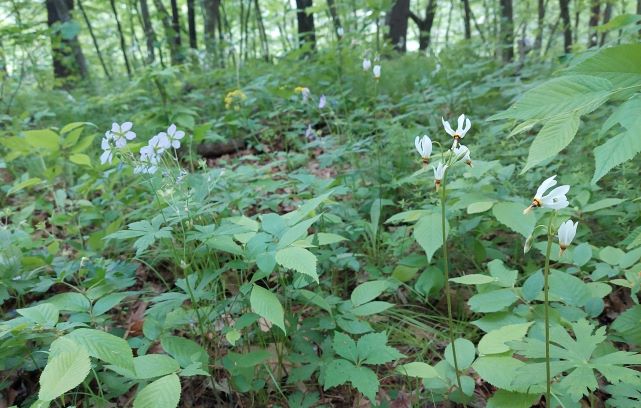
Photo by Mike Mossman Shooting star, downy phlox and golden Alexander holding on where clifftop prairie is succeeding to forest.
Special concern plants included twinleaf (Jeffersonia diphylla), purple-stem cliffbrake (Pellaea atropurpurea) and Sullivant’s coolwort (Sullivantia sullivantii). The lichen community at Honey Creek is especially diverse with several rare and uncommon species that are suggestive of unique, high-quality habitats.
WSO’s Honey Creek Preserve is a rare gem, full of bird song and life, challenges and opportunities. May it always be so!

